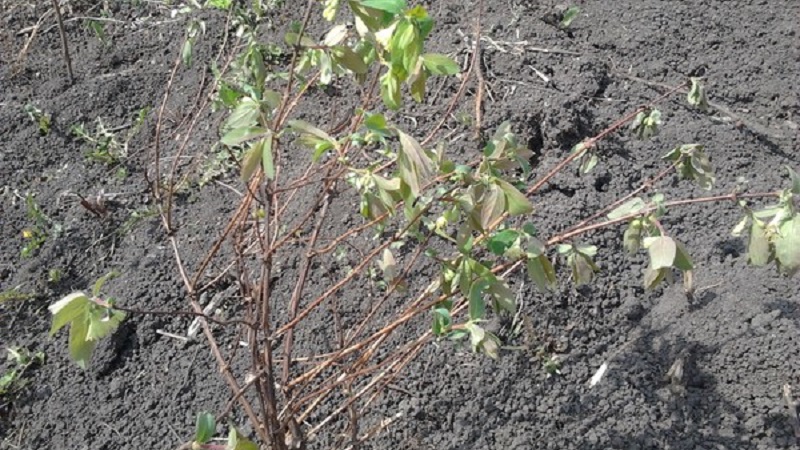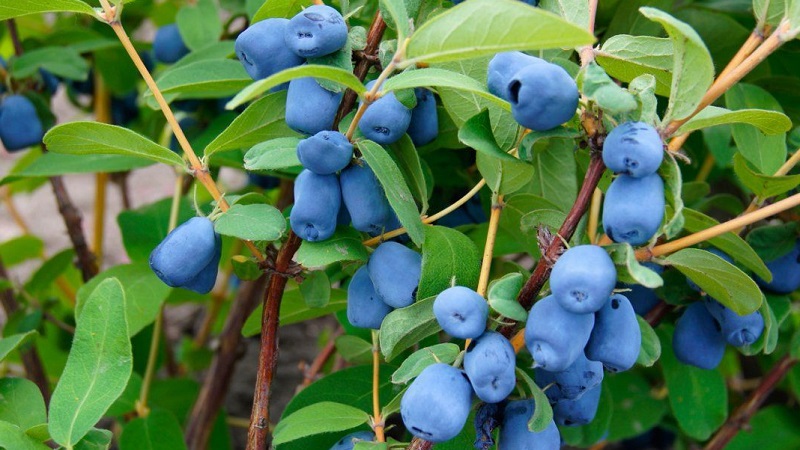What to do if honeysuckle dries up in the garden and why it might happen
It happens that healthy honeysuckle begins to dry out. Leaves turn yellow, fruiting decreases, various pests and diseases appear. Let's figure out why honeysuckle branches dry and how to deal with it.
The content of the article
Why honeysuckle dries up: possible causes
There are many reasons why honeysuckle dries up. Gardeners establish the source of damage by the appearance of leaves, branches, fruits... This phenomenon hides big problems in the form of pests and infections.

Unfavorable weather conditions
Honeysuckle belongs to unpretentious plants, therefore it easily tolerates heat, moisture, windy weather. But during prolonged rains, the root system of the bush is strongly washed out... There is a high level of humidity, which leads to the appearance of powdery mildew, rot.
Intense heat causes the bush to dry out. Leaves turn yellow, the branches become brittle, the root system does not receive the required amount of moisture.
Care errors
Often, beginners make mistakes in watering, feeding, pruning... The shrub prefers a normally moist soil, so it is watered 3-4 times during the entire growing season.
Organic fertilizers are applied only in autumn or early spring. In this case, nitrogen is used during the melting snow. Potassium and phosphorus - in the fall under the root.
Attention! Many gardeners do not form a bush because they find this activity pointless. However, if dry branches and leaves are not removed, the infection will spread throughout the honeysuckle.
Diseases
Honeysuckle is affected by three fungal diseases:
- Powdery mildew. Signs - white bloom on the leaves, a significant decrease in fruiting, deformation of the leaf plates, followed by drying of the bush. The reasons are dampness, nearby seedlings, improper care, the presence of old vegetation.
- Ramulariasis. Signs - brown spots with a white center, thick white bloom, holes in the leaves, a noticeable decrease in yield, the death of the bush. The reasons are dampness, plant residues, heavy soil.
- Sooty fungus. Signs - black soot spots, black sticky bloom, aphids, large spots on the leaves, no berry ripening, the death of the bush. The reasons are dampness, weeds, aphids and improper care.
Pests
Honeysuckle attacked by the following pests:
- Leaf roll. It is not the butterfly that harms the bush, but the caterpillar. They twist the leaves, form a web on them. The pest is capable of destroying up to 80% of the crop.
- Honeysuckle mite. High humidity causes mites to appear. It attracts sooty fungus, sucks the juices from the plant. The leaves are deformed and fall off, and the fruits do not develop well.
- Honeysuckle aphid... A small bug sucks out juices. The plant dries up, the leaves turn yellow. Insects destroy most of the crop.

Why does the seedling dry
After being placed in a new place, the seedling begins to dry out, and the leaves turn yellow. This is due to poor lighting, lack of fertilizers... Another mistake is choosing the wrong seedling. Small plants (up to 30 cm high) and too large (from 1.5 m) take a long time to take root. Additionally, under bad weather conditions and poor care, the shrubs dry out.
Reference. Saplings bought from unscrupulous sellers often begin to wither sharply. This is due to damage, overdrying of the root system.You should carefully examine the honeysuckle - it should have healthy green leaves and smooth shoots.
Mature bush
Healthy mature shrubs dry out due to root damage... Trying to create an air flow to the root system by loosening, the gardener accidentally touches it. Another reason for this phenomenon is infection and disease. In addition to the most common, honeysuckle becomes infected:
- Monoliosis. There is a gradual desiccation of leaf plates, then branches and shoots. Without treatment, the bush dies.
- Mosaic. It rarely occurs, but otherwise it becomes dangerous for the plant. Affected honeysuckle is difficult to cure, so it is dug up and burned.
- Rust. This disease slows down photosynthesis and reduces yields.
Under the influence of diseases, the bush loses its properties... Gradually dries up, freezes in winter, stops growing, completely dies.
Dried branches of honeysuckle
This is due to damage to the root system.... The gardener accidentally grazes the roots while weeding and loosening. Also, the root system is often eaten by rodents.
Other causes are infectious diseases... If they are not eliminated in a timely manner, the bush completely dies and infects neighboring crops.
Leaves dry and turn brown
If the leaves begin to dry and turn brown, the influence of climatic and agrotechnical factors is excluded. Often the causes of this phenomenon are fungal diseases. The main fungal pathogens are cercosporiasis, powdery mildew, ramulariasis, tuberculariosis, and rust.

Decorative honeysuckle honeysuckle dries
Honeysuckle honeysuckle used for landscaping summer cottages. It is distinguished by its aesthetic appeal and delicate, pleasant aroma. The bush is a vine that braids any support.
Culture requires timely pruning... Such a sanitary procedure excludes drying out of the leaves, damage to the shrub with diseases. This variety is not only sick, but is also attacked by the caterpillar of the fingerwing, leafworm, and scale insects.
Reference. Honeysuckle often dries up due to diseases, pests, and improper agricultural practices. If you closely follow the plantings, care for and process them with "Fitolavin", "Gaupsin", "Gamair", such problems do not arise.
What to do when honeysuckle dries in the garden
Drying out leads to the final death of the shrub... For the complete destruction of the focus of infection, the removed parts of the diseased bush are burned as far as possible from the site.
Healthy bushes in late April are sprayed once 0.2% solution of "Fundazol". Additionally, the site is treated with "Fitosporin", "Trichodermin", "Mikosan". Dissolve 2-3 tsp in 10 liters of water. The resulting composition is suitable for irrigation of 100 sq. m of land.
Before flowering, during the period when buds and fruits appear, after harvest shrubs are sprayed with a solution of copper sulfate. Dilute 100 g of the substance in 10 l of water. Processing is carried out four times per season.

Preventive measures
Experienced gardeners say: it is better to prevent shrubs from drying out than to look for methods of struggle later. Therefore newbies take into account the following recommendations:
- Maintain optimal moisture under the bush. Indicators - not less than 75-80%. To do this, create a mulch layer of hay or old leaves.
- Analyze the site. Before planting a seedling in open ground, choose a place where there are no rodents and moles. Otherwise, they will instantly damage the root system.
- Carry out timely pruning... Remove broken, shriveled branches. If the bush is more than 15 years old, the longest and oldest branches are cut.
- Take into account the rules of watering. One shrub requires up to 40 liters of water. Water it 3-4 times for the whole season.
- Regularly inspect the bushes for pests and diseases... The main reason for the wilting of honeysuckle is the attacks of insects that carry various infections.
Conclusion
Compliance with simple rules and preventive measures will allow you to preserve the harvest, keep the honeysuckle in good condition.Despite the fact that the shrub does not require specific care, it is affected by powdery mildew, a sooty fungus. If such a bush is not destroyed, the infection will move to neighboring crops. It is important to regularly inspect the bushes, water them correctly, and maintain optimal humidity.